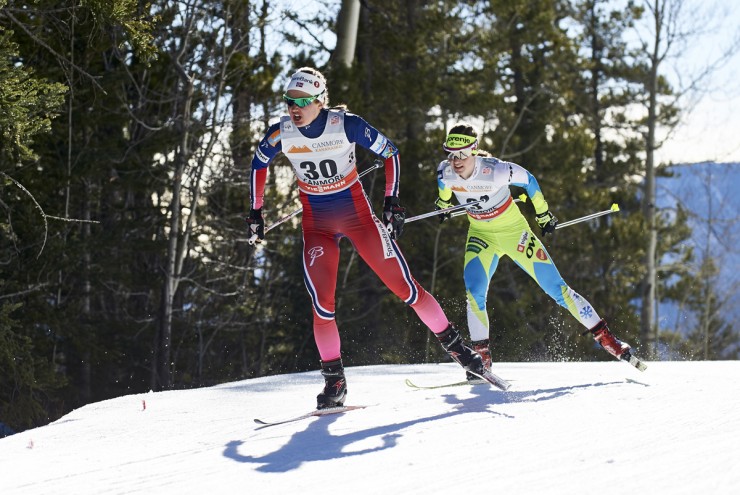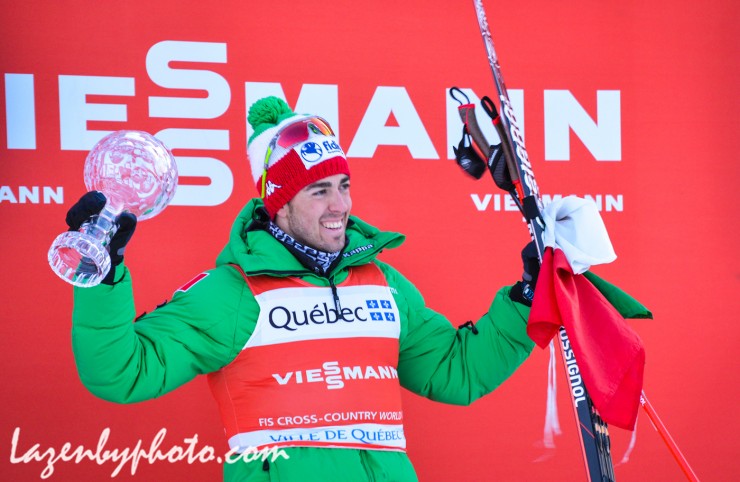
The 2015/2016 awards continue, chosen by the FasterSkier staff based on performances from last season. While not scientific, these points of recognition are intended to reflect a broader sense of the season in review.
The following set of honors goes to outstanding male and female international skiers of the year and the male and female international performances of the year.
Previous categories: Breakthrough Skiers (Canada & U.S.) | Biathletes | Continental (Canada & U.S.) | Coaches | Collegiate Skiers | Juniors| Nordic Combined | Para-Nordic
International Skiers of the Year:
Martin Johnsrud Sundby, Norway
Frozen beard, big-time work ethic, and a perfectly proportioned combo of confidence and humility, in 2016, Norway’s Martin Johnsrud Sundby was a model of supreme day-to-day fitness and season-long endurance. Just a single win from his 2016 World Cup accomplishments would make a season for some and even define a career for others. Here’s a sampling of Sundby’s 2016 race season:
- 14 individual World Cup wins
- Inaugural Ski Tour Canada (STC) win
- Third-straight Tour de Ski title
- A 50 k classic Holmenkollen victory. (It was Sundby’s first Holmenkollen 50 k victory in nine 50 k World Cup starts there).
Known as a distance dominator, Sundby also proved his worth in the sprints. He finished fourth in three sprint races and ended up 13th overall in the Sprint World Cup.
Sundby has taken the overall Crystal Globe the last three seasons. Prior to his three-year grip on the overall, Sundby’s best end-of-season overall ranking was eighth in 2013. Between 2007 and 2012, his end of year rankings were 146th, 68th, 13th, 42nd, 28th, and 19th. Not exactly the numbers we associate with his superstar status.
The years when he has struggled are not lost on Sundby. “To grow old in the profession I have chosen, with the genetic infirmities I have, one must also do much right. I have so sensitive respiratory and lung problems and asthma,” Sundby said according to a translated article.
At 31 years old, and now a father of two, Sundby has much to juggle along with his aspirations for more athletic glory. “No matter how I twist and turn it, I do not have many years left at the top. I must take advantage of the years well,” Sundby said.
No doubt, Sundby has used the last three years well; exploiting a high tolerance for big training loads and a gift to see that training materialize in podiums.
With next year’s World Championships looming, Sundby has a clear goal for 2017; he’s never won an individual World Championship gold. It’s still unclear if Sundby will continue racing into 2018, but an Olympic void also remains; no Olympic golds.
Therese Johaug, Norway
Many athletes are gifted opportunities, but few are able to capitalize. Over the course of a World Cup season, there seems more that can go wrong than right. There’s possible sickness and injury, poor form, bad skis, and other Norwegian upstarts emerging. So much must align for an athlete’s potential to morph into results.
Johaug’s big gift this year was the absence of 2015 FasterSkier international female skier of the year, Marit Bjørgen, due to the birth of Bjørgen’s first child.
To her credit, Johaug made the best of her opportunities and seized both the day and the season. She won her second-career overall World Cup in dominating fashion.
If you’ve ever listened to Johaug interviewed post-victory, you’ll undoubtedly heard her say this: “The shape is good.”
The shape was good from the start of the season in Finland to its conclusion in Canada. During that journey, Johaug only impressed. She ultimately tied Marit Bjørgen’s record of 17 wins in a World Cup season.
She won the Ski Tour Canada, the Tour de Ski and the Holmenkollen 30 k classic. In fact, she won all but three distance World Cup races this season. One of those non-wins was the STC Stage 4 10 k freestyle pursuit in Quebec City. Johaug actually skied that race’s fastest time on the day. Not shabby.
Just a distance skier you say. She placed in the top 10 in five different sprints this season.
Next season will present Johaug just what an elite athlete at the pinnacle of their sport needs; new challenges to stay motivated. Bjørgen, of course, will be back. So, too, will two other Norwegians capable of derailing the Johaug-express, second in the World Cup overall Ingvild Flugstad Østberg, and third overall Heidi Weng.
International Performances of the Year:

Ingvild Flugstad Østberg (Norway): 10 k freestyle at Stage 7 of the STC
Since 2012, Østberg has become a consistent force in the sprint standings. In 2012, she was eighth overall. The next four years culminated with a third, fourth and two successive second-place in the overall sprint standings.
But early this season, Østberg made clear Johaug best keep an eye on her. In Lenzerheide, Switzerland, Østberg scored her first career World Cup distance win. If that race in Lenzerheide was her debut, then the STC’s Stage 7 freestyle individual start was Østberg’s coronation.
In what should have been a Johaug victory or a Weng win, Østberg crushed. She ranked second at the first time check, but upped her speed and punched first and first at the second and third checkpoints. Østberg beat second place finisher Weng by 23 seconds and relegated Johaug (who eventually went on to win the Ski Tour Canada overall) to sixth place (+40.1).
FasterSkier interviewed Østberg during the STC. In particular, she discussed her emergence as a distance threat, not only a sprint shoe-in.
“Many years now that I am a sprinter, but I’ve always said I am not a sprinter,” Østberg said at the time. “Don’t call me a sprinter because I want to be an all-around skier and I want to do good in all kind of distances.”
True to reputation, Østberg was second overall in the sprint World Cup. However, she was third overall in the final World Cup distance standings. Add all that up and you have an all-around skier: Østberg was second for the World Cup overall with 2302 points. Johaug, the overall winner, ended with 2,681 points.
Federico Pellegrino (Italy): skate sprint streak

Perhaps there’s a reason the term “three-peat” just sounds like a nice tidy package of victories. “Four-peat”, on the other hand, just doesn’t sound as familiar. That may be because winning something four times in a row is that much harder to do.
During the 2015/2016 World Cup season, Pellegrino did accomplish a three-peat. He won three consecutive skate sprints. This season, he did one better.
From Davos, to Toblach, to Lenzerheide, to Slovenia, Pellegrino did something unprecedented on the World Cup scene. According to FIS, Pellegrino was the first skier to win four consecutive freestyle sprints.
Coming into the STC, Pellegrino struggled in the classic sprints. In chronological order, here’s Pellegrino’s classic sprint results on the World Cup this season; seventh, 14th, 26th, and 21st. It shows a heavy reliance on his freestyle skills.
The final sprint of the season, Stage 5 of the STC, was a classic sprint. It’s possible that having already locked up the sprint crystal globe — in no small part due to his skate sprint streak — prior to the race boosted his confidence. Pellegrino strided to a Stage 5 classic sprint win.
Pellegrino ends the season as the winningest Italian male ever to ski on the World Cup with eight wins total. All but one of those victories have come in freestyle technique.
Four skate sprint wins in a row was a record. And with a first-ever career classic sprint win to close out the season, it’s a nice goodbye.



